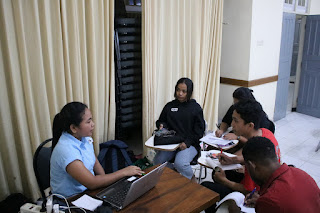By Kresensia Risna Efrieno.
“For some people, social problems are human tragedies. For a social entrepreneur, it is an opportunity to make a change” (Rhenald Kasali).
What comes to mind when we hear the word 'problem'? What is the difference between a problem and a social problem? Not everyone understands social problems. When social problems occur, what young people can do? Stube HEMAT Yogyakarta facilitated students through Social Entrepreneurship training (11-13/11/2022 at Wisma Pojok Indah) to understand social problems around them and how to be a social entrepreneur as the answer.
In the opening, Ariani Narwastujati, S.Pd., S.S., M.Pd, Executive Director of Stube HEMAT introduced what social problems are. Social problems are problems that occur continuously and affect many people. It turns out that various social problems hit the community, such as poverty, unemployment, hunger, and others. Then, what can students as young people do? How can a young person become an agent of change of existing social problems by doing Social Entrepreneurship? There are four things in Social Entrepreneurship which include; 1) There is an element of community empowerment, 2) The efforts undertaken are aimed at generating profits that are used to respond to social problems, 3) Long-term and continuous targets for social change, and 4) Conducted with a business approach and a social approach to address the problems.
In exploring the problem solving, Stube HEMAT Yogyakarta work team guided participants to get to know several social entrepreneur figures, namely Sugeng Handoko, who developed young people in Nglanggeran (Gunungkidul), Goris Mustaqim who raised the enthusiasm of young people in Garut, Gamal Albinsaid, initiated community health services for the poor through waste banks in Malang and Alan Efendhi who empowers village communities in arid areas in Gunungkidul through aloe vera cultivation and business. Not to forget, the progress of three Stube HEMAT activists who returned to their regions and answered existing social problems, such as: 1) Elisabeth Uru Ndaya, S.Pd, in East Sumba saw that women needed to have the power to be independent and productive, so she initiated woman group to learn weaving, 2) Frans Fredi in Lambanapu, East Sumba, who are facing unemployment challenges while young people think agriculture is not prospective and full of price games, so he voiced the movement of young farmers, and 3) In Alor, Petrus Maure initiated the utilization of Alor's local potencies from coconut and candlenut to respond to youth unemployment and local garden produce that has not been optimally processed.
Field exposure becomes a way of comprehensive learning complementing the cognitive understanding gained. Group one visited the Lintas Winongo Garbage Bank in Jetis, Yogyakarta, which encouraged residents to sort waste and sell it at the waste bank to earn additional money. Group two headed to Baros, Bantul to have a dialogue with the Akar Napas Community who saw that the mangrove area was threatened by garbage, the area was getting smaller, so it was necessary to strengthen young people who care about the environment including benefits for the people around the mangrove area. Group three studied at Agradaya (Agararia Berdaya) in Minggir, Sleman which is engaged in helping farmers who cultivate ‘empon-empon’, such as Ginger, Turmeric, and Curcuma to gain prosperity by processing their crops into ready-to-process materials and finished products to be marketed wider. Group four visited the Cindelaras Tumangkar Credit Union in Condongcatur, Sleman as a tool for the struggle of Credit Union members and the support of the poor to be independent and achieve prosperity through financial education and good financial management. Then each group presented their experiences of the study visits and found inspiration for what they could do to address social problems in their respective area.
At the last session, Rev. Sundoyo, S.Si., MBA guided participants in mapping social problems and social entrepreneurship using the Business Model Canvas (KMB) introduced by Osterwalder and Oigneur (2012). In mapping the problems, participants tried to target their respective regions and find problems, solutions, and actions with the concept of social entrepreneurship. The results serve as a guide for participants in following up the training in real action.
When students get opportunities and assistance, they will be the potential next generation of regions bringing changes for a better one, because if not the youth who do it, no one else, and if not now to do it, then there is no other good time. Being social entrepreneur, students can! ***









.jpg)
.jpg)


.jpg)
.jpg)
.jpg)

Comments
Post a Comment